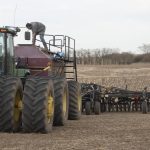The topsoil of one of America’s largest agricultural-producing states is vanishing at an alarming rate, with wind and water erosion directly linked to the cropping practices and to the fencerow-to-fencerow philosophy that farmers have turned to in order to cash in on high prices for corn, soybeans and other crops.
Around Iowa’s western and southern edges, soil losses can exceed 50 tons per acre a year. In the southwestern region losses average 10 to 20 tons per acre annually.
In the middle of that region, however, there is a 3,100-acre commercial farm. Its annual soil loss rate is zero.
Read Also

Sensing the soil: Root cell research finds ‘stress hormone’
Research into how root cells react to soil stressors could help plants better adapt to changes in their climate.
It’s where Seth Watkins lives with his family on the farm established by his great-grandfather James Shambaugh in 1846.
Sometimes, Watkins admits, he’s pessimistic when he looks across the landscape at farms that are suffering severe erosion, and he wonders about the future of agriculture in his home state.
“I’ve got a child who’s going to want to farm,” Watkins said during the recent World Congress on Conservation Agriculture in Winnipeg.
“If she wants to own it, we need to make sure it’s there for her,” Watkins said.
Fortunately, based on his on-farm experience, he believes that it’s a realistic goal.
Watkins was part of a plenary panel discussion about regional perspectives on agricultural conservation in North America.
His views are similar to those contained in a 2011 report from the Environmental Working Group, a private non-profit U.S. organization. It says Iowa farms are losing topsoil up to 12 times faster than the U.S. government will admit.
The USDA’s Natural Resources Conservation Service (NRCS) has estimated soil and water erosion in Iowa averages 5.2 tons per acre of soil a year, slightly higher than the supposedly sustainable annual rate of 5.0 tons.
But the EWG report, titled Losing Ground, found that in some regions of Iowa as much as 64 tons of soil are lost from each acre of land every year.
The report raises a grim warning about the misuse of the Corn Belt’s fertile soil, which took millions of years to accumulate.
“From the dust bowl of the 1930s to the barren moonscapes of today’s Haiti and Madagascar, history is littered with evidence that what nature has provided, unwise practices and policies can rapidly squander,” the report says.
The EWG report, based on research by Iowa State University scientists, paints a shocking picture of what’s happening on Iowa’s farm fields.
It says farmland in 440 Iowa townships encompassing over 10 million acres eroded faster in 2007 than the so-called sustainable rate cited by NRCS. In 220 townships totalling six million acres, the soil loss was twice the sustainable rate.
The EWG report also says the incentive for farmers to maximize production at the expense of the land is bolstered in part by government programs. Those include subsidies for corn required to supply ethanol plants, four of which are within 60 miles of Watkins’ farmyard. Other farm policies that encourage farmers to plant crops on fragile land are also blamed for accelerating the rate of soil loss.
The report says soil loss and run-off are aggravated by “gullies” that reappear during heavy rains on rolling land where farmers have previously tilled, channelling run-off water off the field, complete with soil nutrients.
Watkins said the loss of excess nutrients from farmland is so bad that Iowa today is the second-largest contributor of nitrogen and the third-largest contributor of phosphorus to the “dead zone” in the Gulf of Mexico, where the loss of oxygen caused by agricultural chemicals kills marine life.
There are other more subtle effects of soil degradation flying under the radar. Watkins said surveys show a third of the Iowa’s natural plant and animal species — songbirds, wildflowers and even earthworms —
are classified as “conservation concern” — the first step on the path to being declared endangered species.
That’s the bad news. Now the good.
Watkins is part of a small but slowly growing number of Iowa farmers who are forgoing conventional agricultural methods to practise land stewardship instead of just aiming for increased production.
Watkins, his wife Christy and their children Spenser (12) and Tatum (nine) operate Pin Hook Farm near Clarinda, Iowa. They own 500 acres and rent another 2,600 acres.
The family’s conservation methods include minimum tillage, cover crops, wildlife set-asides, riparian buffers, terraces and ponds to retain water on the landscape. The farm’s 550 beef cows are late-season calvers — a strategy which Watkins said conserves fuel. He also practises a form of strip farming which integrates native prairie grass into his cropland.
The results are evident in the soil. Watkins says soil erosion on Pin Hook Farm is zero while precipitation and nutrient retention are higher than on conventionally cropped farms.
“We find that, if we use each acre to its best use, it gives the best long-term return.”
But doing this is the easy part. Watkins says it’s not all that hard to switch a farm to no till and cover crops. Instead, the hard part is to get other farmers to undergo a mindset change away from production-driven farming and toward sustainable ag, he said. “We have to show them that there are better ways.”
Watkins is a realist. He knows farmers can’t go back to the horse-and-buggy days of subsistence living on a 160-acre holding. But, as he considers the damage that intensive agriculture is doing to Iowa, Watkins believes taking better care of the soil is the answer to an improved quality of life.
Said Watkins: “It’s good for my business, it’s good for my community, it’s good for my state.”
This article first appeared in the July 2014 Country Guide special section on sustainability.















